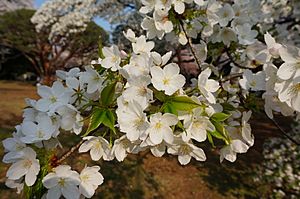Oshima cherry facts for kids
Quick facts for kids Oshima cherry |
|
|---|---|
 |
|
| Scientific classification | |
| Genus: |
Prunus
|
| Species: |
speciosa
|
The Prunus speciosa, also known as the Oshima cherry, is a special type of cherry tree. In Japan, it's called オオシマザクラ (Oshima zakura). This beautiful tree originally comes from Izu Ōshima island and the Izu Peninsula on Honshū island, which are both near Tokyo, Japan.
Contents
About the Oshima Cherry Tree
The Oshima cherry is a deciduous tree, which means its leaves fall off every year. It usually grows to be about 4 to 12 meters (about 13 to 39 feet) tall.
Its leaves are typically 5–10 centimeters (2–4 inches) long and 3–6 centimeters (1–2.5 inches) wide. They have edges that look like they have two sets of teeth, and their tips are pointed.
The flowers are quite large, about 2.5–4 centimeters (1–1.5 inches) across. Each flower has five bright white petals, golden yellow stamens (the parts that make pollen), and brown sepals (the small leaves that protect the bud). These flowers grow in bunches during the spring. They are also hermaphroditic, meaning each flower has both male and female parts.
After the flowers bloom, the tree produces small black cherries. These fruits are about 1 centimeter (less than half an inch) wide.
There's a very old Oshima cherry tree on Ōshima island that is about 8 meters (26 feet) around and 800 years old! It's so important that it has been named a national treasure in Japan.
Growing Oshima Cherries and Their Varieties
The Oshima cherry is a very popular ornamental tree. This means people grow it just because it looks beautiful. Its large, eye-catching flowers make it a favorite for gardens and parks. These trees like sunny spots and soil that is moist but drains water well.
There are many different kinds of Oshima cherry trees, called cultivars. The Oshima cherry is also a parent to many other famous sakura (flowering cherry) varieties.
Many of the cherry blossom trees that came from the Oshima cherry are known as the Cerasus Sato-zakura Group. These varieties often have many petals, making their flowers look very full. A well-known example is the 'Kanzan' cherry.
Oshima cherries are special because they tend to change easily, often growing flowers with many petals. They also grow quickly, have large, beautiful flowers, and smell wonderful. Because of these features, people have loved them for cherry blossom viewing for a very long time.
During the medieval Kamakura period in Japan, as more people moved to the southern Kantō region, Oshima cherries were brought from Izu Ōshima Island to Honshū. People started growing them there, and eventually, they were brought to the capital city, Kyoto. Over time, many new types of cherry blossoms were created from the Oshima cherry, especially during the Edo period. Many of these beautiful varieties are still enjoyed today.
The Oshima cherry is also one of the parent trees for the famous Yoshino cherry.
Food Uses
The small black fruit of the Oshima cherry is safe to eat. The dried flowers can be used to make a special tea. The leaves, sometimes called "sakura leaf" or "cherry leaf," are used in cooking and traditional medicine. For example, they are used to wrap a sweet treat called 'cherry tree rice cake'. However, the Oshima cherry is not the only type of cherry tree whose leaves are used this way.
Naming the Oshima Cherry
This plant was first described by a scientist named Gen'ichi Koidzumi. He called it Prunus jamasakura var. speciosa. Later, another scientist named Collingwood Ingram decided it was different enough to be its own species, so he gave it the name Prunus speciosa.
Sometimes, people consider it to be the same as Prunus lannesiana, or a type of it, called Prunus lannesiana var. speciosa. The word speciosa comes from Latin and means "the beautiful." This name perfectly describes the tree when it is covered in its lovely blossoms.
Images for kids
-
Prunus speciosa in the Shinjuku Gyoen.






